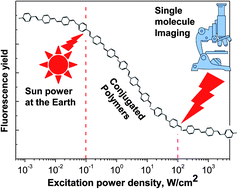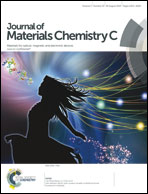Photo-induced fluorescence quenching in conjugated polymers dispersed in solid matrices at low concentration†
Abstract
When isolated conjugated polymer (CP) chains are studied by single molecule spectroscopy, excitation power density in the range of 10–1000 W cm−2 is normally used. We show that at such excitation power densities the fluorescence ability of CPs is significantly reduced. A new methodological approach allowed us to measure the fluorescence quantum yield (QY) of thin matrix polymer films doped with fluorophores at very low concentration using fluorescence microscopy. Fluorescence QYs of different conjugated polymers (P3HT, MEH-PPV, PFBV and cyclodextrin-coated PFBV-Rtx) and a reference perylene diimide dye dispersed in the PMMA matrix were measured as a function of the excitation power density that ranged from ∼10−4 to 100 W cm−2. Already at an excitation power of 0.1 W cm−2 (the power density of the sunlight at the Earth) a detectable reduction of the fluorescence QY was observed for most of the polymers. The origin of the QY reduction is exciton annihilation by photo-generated triplet and/or change-transfer states. Insulation by cyclodextrin was found to decrease significantly the effect of non-emissive quenching states.


 Please wait while we load your content...
Please wait while we load your content...